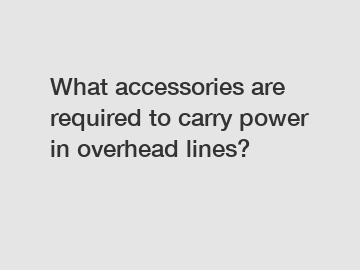What accessories are required to carry power in overhead lines?
What accessories are required to carry power in overhead lines?
To efficiently transmit electrical power through overhead lines, a range of accessories is necessary. These accessories play a crucial role in ensuring reliable power delivery while also protecting the infrastructure. In this article, we will explore the various accessories required for carrying power in overhead lines, their importance, and the impact they have on the overall electrical grid.
The first and foremost accessory required for carrying power in overhead lines is the conductor. Conductors are typically made of aluminum or copper and are responsible for transmitting electricity from the power generator to the consumers. The selection of the conductor depends on various factors such as the current-carrying capacity, voltage drop characteristics, and environmental conditions. Aluminum conductors are commonly used due to their lower cost and lighter weight, while copper conductors offer better conductivity and higher mechanical strength.

Insulators are another essential accessory in overhead line installations. These devices are used to support the conductors and ensure they are electrically isolated from the supporting structures. Insulators prevent leakage of electrical current, reduce power losses, and mitigate the risk of structural damage. Porcelain, glass, or polymer insulators are commonly employed, with their selection dependent on factors such as mechanical strength, resistance to electrical and environmental stresses, and cost-effectiveness.
In order to properly secure the conductors and maintain the required sag, various fittings and supports are utilized. These fittings include suspension clamps, tension clamps, and strain clamps, among others. Suspension clamps are used to hang the conductors from supporting structures, while tension clamps are employed to maintain tension in the conductor and minimize sag. Strain clamps, on the other hand, provide support to prevent the conductor from sagging excessively under different environmental conditions. These fittings not only facilitate proper conductor alignment but also ensure optimal electrical performance and safety.
Moreover, protective accessories such as lightning arresters and surge arresters are critical in safeguarding the overhead lines from lightning strikes and voltage surges. Lightning arresters are designed to divert lightning currents safely to the ground, preventing damage to the conductors and associated equipment. Surge arresters, on the other hand, protect the lines from transient voltage surges that may occur due to lightning strikes or switching operations. These protective accessories not only enhance the reliability of the overhead lines but also minimize downtime and potential damage caused by electrical disturbances.
In conclusion, a range of accessories is required to carry power in overhead lines effectively. These accessories, including conductors, insulators, fittings, and protective devices, are essential in ensuring reliable power transmission, protecting infrastructure, and minimizing power losses. The proper selection and installation of these accessories play a vital role in the overall performance and stability of the electrical grid. By investing in quality accessories and adhering to industry standards, power utilities can achieve efficient power delivery and enhance the resilience of their overhead line systems.
For more information, please visit corona ring design, china preformed suspension clamp set for opgw manufacturers, opgw suspension clamp.

Comments
0